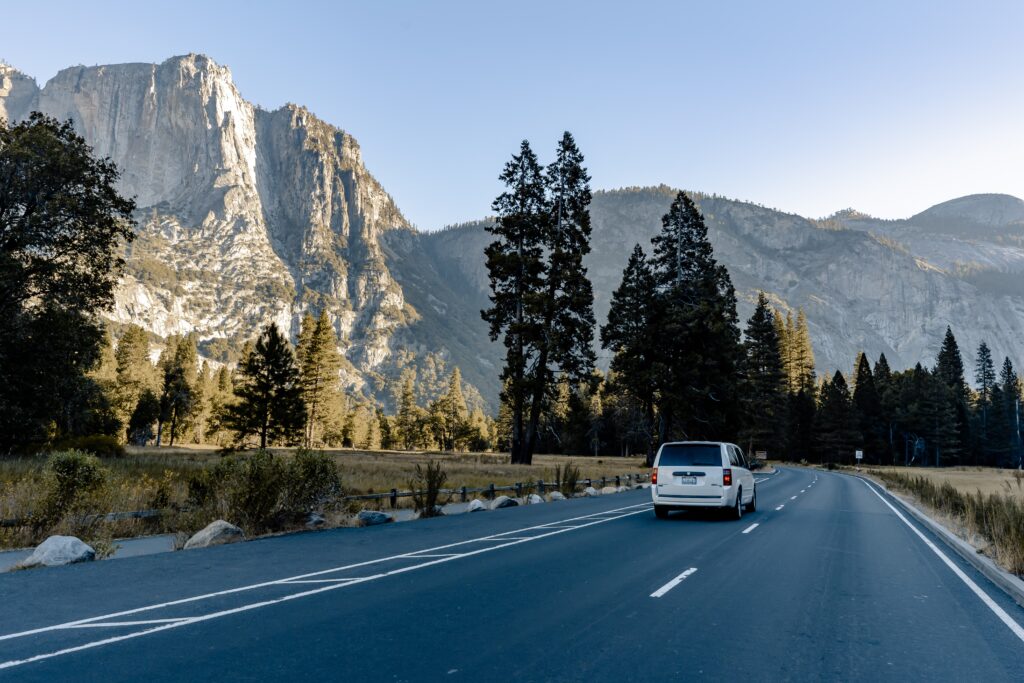If you’ve been considering van life, full-time or part-time, and have a furry companion you want to bring along on your travels, there are a lot of things to consider.
Van life with dogs brings an already challenging lifestyle to a new level. We interviewed Sierra, who has been traveling full-time with her dog, Snow, in a campervan since 2020. In that time she’s learned a lot about the pros and cons of traveling with a dog.
In this article, she shares the pros and cons of van life with dogs and some tips she’s learned along the way to help keep you (and your dog) happy and healthy!
Table of Contents

Pros of Van Life with Dogs
First things first, let’s start with the positive side of van life with dogs. It’s not always rainbows and butterflies, but in my opinion, I wouldn’t trade my dog’s companionship for the possibly simpler travel regimen.
Companionship
It’s no secret that van life can be lonely at times, especially for a solo female traveler like myself. Having my dog with me as a constant sidekick makes time “alone” much easier. Granted, I am quite an introvert, but I can confidently say that I would not have had the courage to start this lifestyle without my dog.
Security
My dog looks sweet and harmless, but his bark sounds like a dog about ready to bite your head off. He is protective of our campervan, so if someone comes up to us that he doesn’t know, he will bark at them. On more than one occasion, strangers have attempted to approach our campervan without an invitation and then stopped when my dog alerted me.
Dogs are also more in tune with our surroundings, so they will hear or see something before we typically will. This is helpful if there are other animals or humans around. My dog has alerted me to cows, coyotes, snakes, and even other dogs that come by camp.

Routine
Having a dog with you forces you to keep some sort of routine. My dog knows when it’s mealtime, tells me when it’s time to go for a walk and tends to wake up at the same time every morning. It’s helpful to have a companion that helps you stay on a routine, even if it’s a loose one.
Exercise
Dogs need exercise just like we do, but when you have a dog, you’re more inclined to get out on those walks or hikes for your dog’s sake. If you miss an exercise opportunity, your dog will show their distaste, especially when living in such a small space.


Cons of Van Life with Dogs
As with most things, with the good comes some bad. For me, these negatives are well worth the rewards I get from always having my dog with me. But for some, these might be deal breakers, so consider both sides before heading out on your adventure with your canine companion.
Temperature regulation
The number one thing I hear people asking about is how to keep your dog safe in a campervan when temperatures fluctuate, specifically in hot weather. Some campervans have built-in air-conditioning units, but unless you are plugged into shore power or have a very robust electrical system, you won’t be able to run one for very long off-grid.
The reality is, if it’s too hot and you don’t have air conditioning, you leave the area and go somewhere with cooler temps. If you are able to regulate the temperature inside your campervan by opening doors and running a vent fan, you can plan your day accordingly and run errands early in the day before it gets hot. Then head back out to wherever you are camping and open up your campervan to let air circulate through.
It’s important to understand that vehicles can reach deadly temperatures in less than an hour when parked unattended on hot days. Even with a well-insulated campervan, temperatures can significantly increase while you’re in the grocery store.
Pro tips:
- Plan your errands early in the day before temperatures start to climb
- Have good insulated reflective window coverings you can put up in your campervan to help block the heat
- Keep a window cracked or roof vents open and a fan running when you leave your campervan for any length of time
- Use a temperature monitoring device, like Waggle, that you can have in your campervan so you can check that your dog isn’t too warm while you’re away from the campervan
- Always keep plenty of water available for your dog, preferably in a spill-proof water bowl
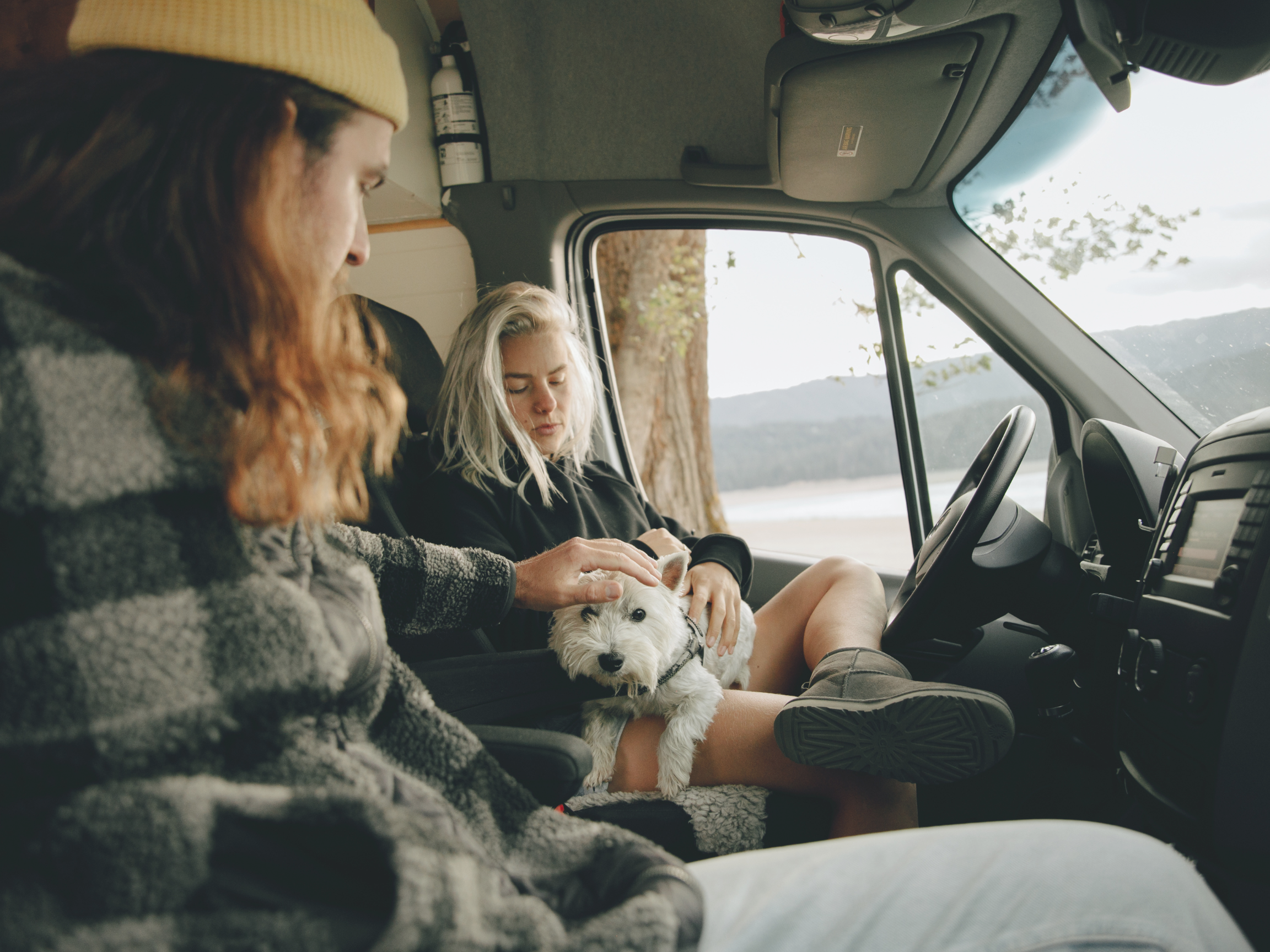
Healthcare
Much like our own health, keeping your dog healthy on the road can be challenging. When you don’t have access to your primary veterinarian, if something happens and your dog needs medical attention, most vets require a full examination before they will treat whatever is ailing your dog. This can bring added expenses and the headache of always having to keep your dog’s medical records with you.
Pro tips:
- Ask for electronic copies of your pet’s vet visits and vaccination records to be emailed to you after every vet visit, and keep them all in a specific email folder.
- Maintain a spreadsheet including vet visits, vaccination dates, and other health-related information (such as flea and tick prevention dosing dates).
- If you travel to one specific location regularly, try to schedule your pet’s annual exam and vaccinations with a vet local to that area.
- Have pet insurance and some money saved for any unforeseen vet visits.
- There are nationwide chain veterinary clinics, like Thrive, that make record-keeping easy, but I haven’t personally used a clinic service like this, so I can’t attest to it.
Dirt and fur
I hope you really love your dog, because you will end up eating their fur at some point, I guarantee it. With my dog, it’s gotten to the point where I don’t even bother pulling fur out of my meals (don’t judge!) because I’d probably spend more time doing that than enjoying my meal.
Your campervan will also be dirty all the time. Van life is dirty on its own, but van life with dogs guarantees you will have a perpetual path of dirt, sand, sap, grime, and if you’re really lucky, some cow poop brought into your van on a regular basis.
Pro tips:
- Shake out blankets, rugs, and dog bedding daily
- Get a small rechargeable vacuum to help with fur and dirt control
- Keep a bottle of no-rinse dog shampoo to help keep your dog’s fur clean and smelling nice
- Utilize self-serve pet washing stations – these can be found in many pet stores and even some car washes!
- Brush your dog often between baths
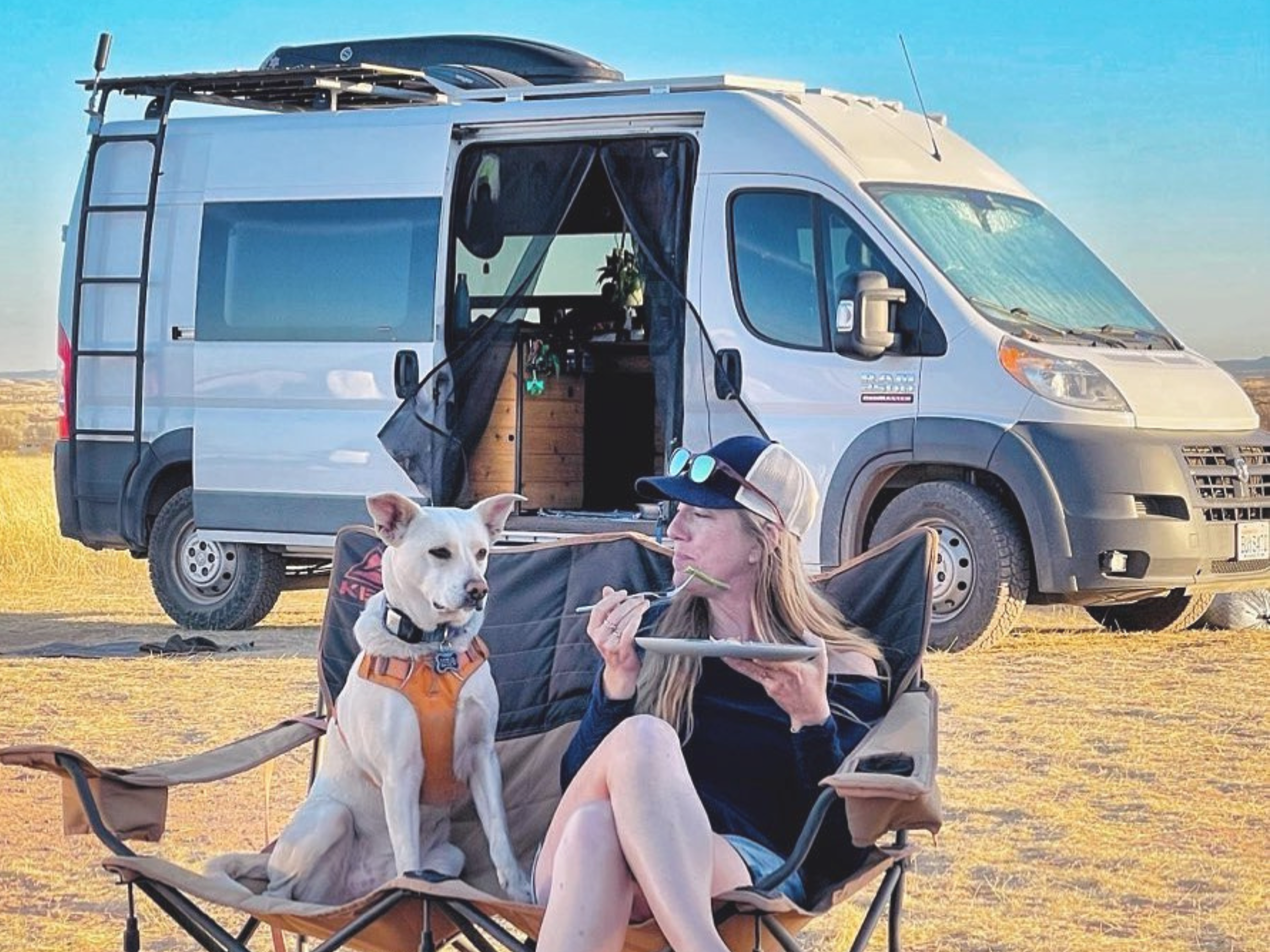
Space constraints
Even if you have a small dog, having limited space in your campervan can be challenging when living van life with dogs. Between food storage, bedding, toys, and everyday items like leashes and poop bags, you’ll have valuable space being taken up by your dog’s gear.
Pro tips:
- Keep all kibble and treats in a sealed container to help prevent rodents from getting into it
- Monitor your feeding and understand how many days worth of food you can store
- Keep leashes, harnesses, and poop bags easily accessible since you’ll be using them multiple times a day – I have hooks on my door they all hang from
Finding consistent food
I’ve found it particularly difficult to find consistent food for my dog while traveling. Since I’m limited on space, I never stock up on food and treats, but replenish as I go through cities. Sometimes, pet stores are out of what I need, and I don’t want to switch food for fear of making my dog sick.
Pro tips:
- Find a popular, highly-rated dog food brand that is available in a large pet store chain, such as PetSmart or Petco.
- If you tend to stay in one location for longer periods of time, find a food you can order and have delivered if you can’t find it locally.
- Supplement your dog’s food with a raw diet, or feed them 100% raw. You can typically find good-quality meat, organs, and dog-friendly veggies in any grocery store. Feeding your dog a raw diet requires careful consideration and balancing food types to ensure proper nutrition. I highly recommend the book The Forever Dog if you want to consider feeding your dog a raw diet.
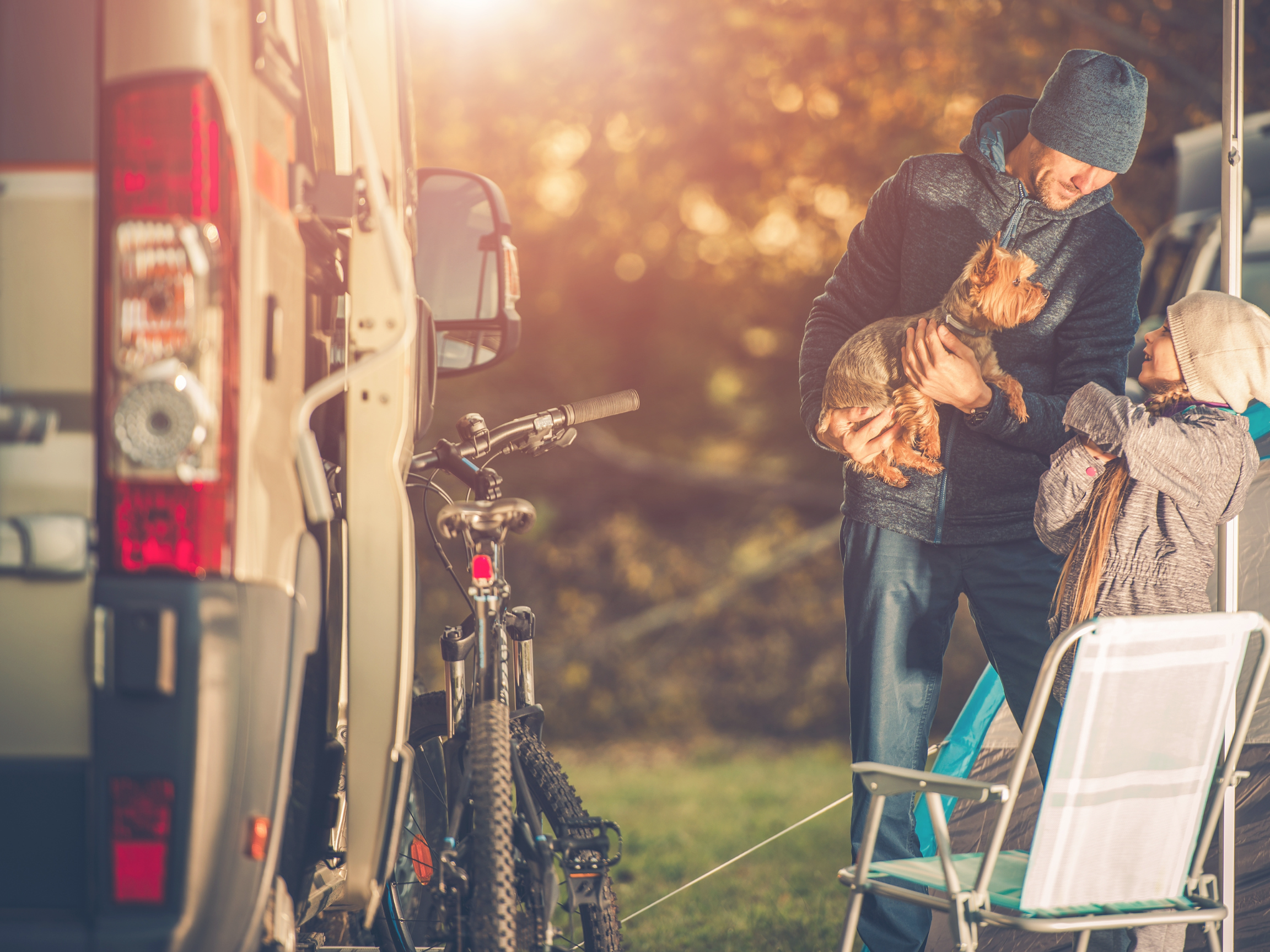
7 More Tips for Traveling Full-Time with Dogs
- Plan Ahead: Research pet-friendly destinations, parks, and trails along your route. Remember that most national parks don’t allow dogs on trails, and some state parks do the same.
- Create a Comfortable, Safe Space: Dedicate a cozy corner in your van for your dog to relax and rest. If you have the room, you can incorporate a crate for your dog as well.
- Stick to a Routine: Dogs love routine. Establish a consistent daily routine for feeding, exercise, and bathroom breaks to keep your dog happy and healthy on the road.
- Exercise Regularly: Prioritize regular dog-friendly activities (both physical and mental) to keep your dog happy and stimulated, preventing boredom and behavioral issues.
- Pack Essential Supplies: In addition to food and water, remember to bring medications, first aid supplies, and grooming essentials to meet your dog’s needs while traveling.
- Stay Vigilant: Monitor your dog’s behavior and health closely for signs of distress, discomfort, or illness, and seek veterinary care if necessary.
- Practice Patience and Flexibility: Remain patient and flexible when unexpected challenges arise, adapting your plans to accommodate your dog’s needs.
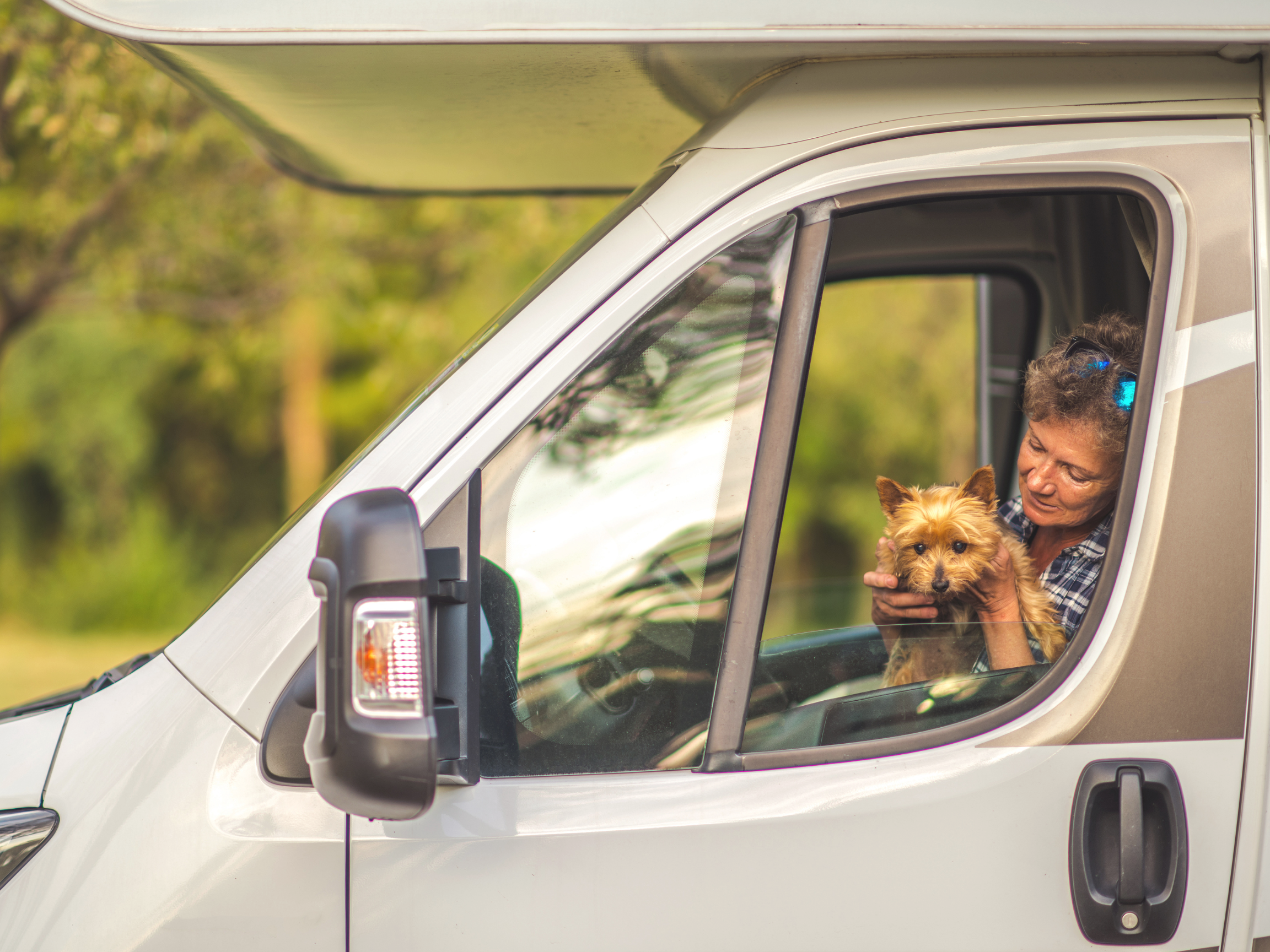
Is Van Life With Dogs Right for You?
Van life with dogs is a rewarding and fulfilling experience, offering endless opportunities for adventure and bonding with your furry friend.
By considering the pros and cons and implementing practical tips for traveling full-time with dogs, you can create unforgettable memories and forge a deeper connection with your canine companion on the open road.
So pack up your van, grab your dog, and embark on the journey of a lifetime—it’s a paw-some adventure waiting to be unleashed so you both can go and Find Your Outside™!
